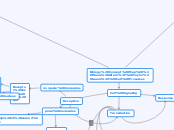av Moses Alfaro 7 år siden
167
BiologyConceptMapLatham
Cell processes such as replication and transcription are vital for genetic continuity and function. In replication, the process begins at specific DNA sequences called origins of replication (

av Moses Alfaro 7 år siden
167

Mer som dette
other proteins, such as RNA polymerase can unwind the DNA for other processes.
DNA helicase untwists the double stranded DNA at the replication forks, seperating the parental strands and making them available as template strands
SSB's come in and bind to the unpaired DNA strands, keeping them from re-pairing.
A primer is formed during DNA synthesis, which is a short strand of RNA, which is synthesized by the enzyme primase.
The new DNA strand will start from the 3' end of the RNA primer. Enzymes called DNA polymerases catalyze the synthesis of new DNA by adding nucleotides to the 3' end of a pre-existing chain.
DNA strand can only elongate in the 5' to 3' direction.
DNA polymerase III must work along the other template strand in the direction away from the replication fork. The DNA strand elongating in this direction is called the lagging strand.
Lagging strand is synthesized discontinuous in fragments, called Okazaki fragments.
DNA ligase comes in and seals the gaps between the fragments
DNA replication is complete after this step.
RNA Processing
5' end receives a 5' cap, which is a modified form of guanine
At the 3' end, an enzyme adds 50-250 more adenine (A) nucleotides, forming a poly-A tail
RNA splicing occurs, where large portions of the RNA molecules are removed (introns) and the remaining portions (exons) are reconnected
the removal of introns is accomplished by a large complex made of proteins and small RNA called a Splicesome.
joins the remaining exons together in the RNA strand.
TRANSCRIPTION (Eukaryotes)
Ribosome bind to mRNA at the start codon.
tRNA recognizes the codon that matches up to its anti-codon.
tRNA would come in through the A site and the anticodon base pairs with the complementary mRNA codon.
codon recognition requires one molecule of GTP
the P site holds the growing strand of polypeptides. When the tRNA from the A site transfers to the P site, the amino acid will attach to the polypeptide chain. The tRNA exits at the E site after the amino acid is added to the polypeptide chain.
Elongation continues until a stop codon reaches the A site. A release factor binds to the stop codon in the A site
cause the addition of a water molecules which breaks the bond between the completed polypeptide and the tRNA in the P site.
the two ribosomal subunits dissociate with hydrolysis of two GTP molecules.
after the tRNA leaves the ribosome, another tRNA will come to the A site and begin the cycle again.
The amino acids will be added on the carboxyl end on the growing polypeptide chain by a peptide bond in the P site. The large ribosomal unit catalyzes the formation of that peptide bond.
matching up of tRNA and amino acids is carried out by a family of related enzymes called aminoacyl-tRNA synthetases.
splicesome binds to several nucleotides along an intron.
Help ribosomes attach to 5' end of the mRNA
Facilitate the export of mature mRNA from the nucleus
RNA poly II transcribes the polyadenylation signal (AAUAAA)
RNA poly II unwinds DNA double strands and RNA synthesis begins at the start point on the template strand (3' to 5')
Does not need SSB, primer, or helicase to begin
the signaled protein will either slow down or speed up transcription
needs help of second messengers
Membrane Receptor
Ion channel receptor
signal molecule binds to receptor of an enzyme with it's gate closed.
when the signal molecules is bound the gate opens and allows ions to travel into the cell
signal molecule comes off and the gate becomes closed again
tyrosine kinase receptor
two signal molecule bind to the signal molecule binding sites of two tyrosine kinase receptors
through dimerization, the two receptor tyrosine kinase proteins join together to make a dimer.
6 molecules of ATP add a phosphate on to 6 tyrosines, this fulling activating receptor tyrosine-kinase.
G-protein receptor
signaling molecule bings to GPCR (making it active)
Active GPCR binds to G-protein and converting GDP to GTP making it an active protein.
The G-protein comes off of the GPCR and attaches to an inactive enzyme (i.e. adenylyl cyclase) making it active.
Adenylyl Cyclase (enzyme) converts ATP to cAMP, which is considered to be a second messenger
phosphodiesterase converts cAMP to AMP
cAMP activates protein kinase A, thus starting the phosphorylation cascade
active protein kinase A transfers a phosphate from ATP to an inactive molecule of protein kinase B, thus activating the second kinase.
protein phosphatases catalyze the removal of phosphate groups from the proteins, making them inactive and available for resue
active protein C phosphorylates a protein that brings about a cellular response to the signal
When the G-protein detaches from the enzyme, a phosphate is released making the enzyme inactive again
Receptor inside the cell
In the nucleus
In the cell's cytoplasm